Museums and Exhibitions in New York City and Vicinity
| Home | | Museum Guide | | International | | Architecture & Design | | Theater |
GLENN LONEY'S MUSEUM NOTES
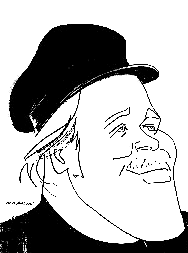
|
|
|
Caricature of Glenn Loney by Sam Norkin. |
|
Farewell,
Troubled 2006! *
Looking
Forward To Bright New 2007! *
A
New Look for Curator's Choice in 2007! *
At
the Metropolitan Museum of Art-- *
NAN
KEMPNER: AMERICAN CHIC *
GLITTER
& DOOM: German Portraits from the 1920s *
LOUIS
COMFORT TIFFANY & LAURELTON HALL: *
An
Artist's Country Estate *
O
TANNENBAUM, O TANNENBAUM! *
[Equal-Time
for Menorahs?] *
At
the Morgan Library & Museum-- *
SAUL
STEINBERG: ILLUMINATIONS *
At
MoMA: The Museum of Modern Art-- *
MANET
& THE EXECUTION OF MAXIMILIAN *
BRICE
MARDEN: A Retrospective of Paintings & Drawings *
FOCUS:
PAUL KLEE *
OMA
IN BEIJING: China Central Television Headquarters *
DIGITALLY
MASTERED: *
Recent
Acquisitions from the Museum's Collections *
At
the American Museum of Natural History-- *
GOLD:
Treasure, Beauty, Power *
At
the Frick Collection-- *
DOMENICO
TIEPOLO (1727-1804): A New Testament *
MASTERPIECES
OF EUROPEAN PAINTING: *
From
the Cleveland Museum of Art *
CIMABUE
& EARLY ITALIAN DEVOTIONAL PAINTINGS *
Other
Frick Attractions: *
At
the Brooklyn Museum-- *
RON
MUECK *
TIGERS
OF WRATH: *
Watercolors
by Walton Ford *
At
the Jewish Museum-- *
ALEX
KATZ PAINTS ADA *
At
the Neue Galerie-- *
JOSEF
HOFFMANN: Interiors, 1902-1913 *
DIE
GOLDENE ADELE & GUSTAV KLIMT: *
The
Saga Continues: Art-Prices Soar! *
At
the Whitney Museum of American Art-- *
ALBERS
& MOHOLY-NAGY: *
From
the Bauhaus To the New World *
KIKI
SMITH: A Gathering, 1980-2005 *
At
the Guggenheim Museum-- *
SPANISH
PAINTING FROM EL GRECO TO PICASSO: *
Time,
Truth, & History *
At
the New York Public Library for the Performing Arts-- *
500
YEARS OF ITALIAN DANCE: *
Treasures
from the Cia Fornaroli Collection *
STARS
& TREASURES: 75 Years of Collecting Theatre *
At
the Bard Graduate Center Galleries-- *
JAMES
"ATHENIAN" STUART, 1713-1788: *
The
Rediscovery of Antiquity *
At
the New-York Historical Society-- *
NEW
YORK DIVIDED: Slavery & the Civil War *
At
Galerie St. Etienne-- *
FAIRY-TALE,
MYTH, & FANTASY: *
Approaches
to Spirituality in Art *
MODERNISM
& OTHER SHOWS: *
Looking Forward To Bright New 2007!
Do the Arts Have a Role To Play,
Helping America Build Democratic Nations in the Middle-East?
This is a purely Rhetorical Question. Obviously, the Arts do not, as America is incapable of Building Nations--Democratic or otherwise--in the Middle-East. Or elsewhere…
And, as for the Arts in their many guises, you may well remember that the American Invasion Plan for Iraq made no provision for protecting the priceless collections of Iraq's National Museum.
The problem now seems to be whether American Democracy can be preserved from the ideological onslaughts of the perverse NeoCons. And the ongoing depredations against Traditional American Freedoms by the Bush White House.
You may recall that Paul Wolfowitz--one of the leading NeoCon Ideologues pushing for Regime Change in Iraq--retired from the Department of Defense when it became clear he had helped launch an Epic Disaster, to become Head of the World Bank! Such are the Rewards of Failure.
So why should American Artists expect a Call to Serve Their Country in any of the many ways that the Arts can help build healthy, happy societies and to heal what has been savaged and torn asunder? And they can also forget about programs to support practicing-artists, to train young talents, and to make the Arts an important part of school-curricula at all levels…
The best we can hope for in the New Year of 2007 is that aspiring young artists, Established Artists, Curators, Museum-Directors, and even Art-Critics & Arts-Journalists will do all that they can--on their own initiatives--to make the Arts Important in American Life.
A New Look for Curator's Choice in 2007!
Usually, your scribe's columns for NYMuseums.com are headed with a Month-date only. For this final year-end report, however, the full date is European-style: 24 December 2006.
The reason for this is that on that date, your roving arts-reporter was 78 years old! This might help explain to some readers of this site why I do not cover every Museum Exhibition in New York City. Nor do I even attempt to report on the many, many gallery-shows constantly opening. Although many galleries now send me cards announcing their new shows…
I cannot do so: I do not have the Time.
It's not a problem of Energy or Will: I would take a look at almost everything if I had the time to do so, but I am also the Senior Correspondent of NYMuseums' sister-site, NYTheatre-Wire.com, which requires that I see almost every new show On & Off-Broadway.
Not to overlook those Oddities which may spring up in attics or basements beyond Avenue A or over on Court Street in Brooklyn. Then there's the Papermill Playhouse, way over in New Jersey…
Not to overlook theatre in Chicago, San Francisco, & Shanghai, when travel permits. Or in London or Leningrad--as it then was, or Mexico-City or Paris or Warsaw or Copenhagen or Riga or Seville or Sofia, Bulgaria.
I used to spend all three summer-months--between Spring & Fall Semesters at Brooklyn College & the CUNY Graduate Center--covering Theatre, Opera, & Dance all over Europe, East & West. But, after my 60th birthday--when I wrongly thought I'd stop counting--I had to reduce this to two months.
My family in California was growing ever older and needed some attention… Also, there was the annual Shakespeare Festival nearby in Ashland, Oregon! Plus ACT in SanFran and the Berkeley Rep!
This summer was my 50th Anniversary at the famed festivals of Bayreuth, Bregenz, Edinburgh, Munich, & Salzburg! Over the past half-century, I have saved production-photos from all those festivals--an almost unrivaled ArtsArchive: the great years of Maestro Herbert von Karajan at Salzburg, among others! At both Bayreuth & Salzburg, critics had to buy the actual photos! So my photo-archives have a $$$$ value as well as a cultural one.
With the approval of the various festivals--and at no cost to them--the not-for-profit Lightning New Media has created individual sub-websites for all five fests, which will eventually be freely available under their over-arching website: ArtsArchive.biz.
In addition to the Festival production-photos, there will also be many of my own INFOTOGRAPHY™ photos of the festival-cities and their major landmarks and festival-venues.
Over the decades, I have interviewed many famed artists, directors, designers, conductors, & arts-managers for publications such as Opera News, Ballet News, Opera Monthly, Theatre Crafts, Entertainment Design, After Dark, Dance Magazine, Theatre Design & Technology, and other national publications.
All these audio-interviews made at--and about--the major festivals will be online as well. Also as many of my reports over the past fifty years as can be found in my extensive print-publication-files. This will include festival columns from NYTheatre-Wire dating back to 1994!
[Need I note that this is taking a great deal of my available time--and not a little cash-outlay…]
This site will also host my printed-archive of fourteen years of creating, writing, taking-photographs-for, & editing both The Art Deco News and The Modernist. Under the title of the Glenn Loney Book Shop all my out-of-print books and previously unpublished arts-books will be available online on the ArtsArchive.biz website as well. This is also taking a lot of time--and money--in the scanning, editing, & formatting for the website.
Actually, as the Historian--and also an Awards-Nominator--for the Outer Critics Circle, an awards-voter for the Drama Desk, and a member of the American Theatre Critics Association and the International Association of Theatre Critics--for which I was last month one of two Official American Delegates to the "Extraordinary Congress" of IATC in Seoul, Korea--I have a rather full-schedule.
I finally had to give up full-time membership in the Theatre Historical Society, the American Society for Theatre Research, and its counterpart, the International Society for Theatre Research.
But I am still a member of the Music Critics of North America and the Dance Critics Association. I did not join the Art Critics--too many dues to pay--primarily because I think of myself on this site as merely an Arts-Reporter or Arts-Journalist.
But even a journalist can form an opinion.
After all, I studied Art History at the University of Wisconsin with no less an expert than actress Uta Hagen's father, Prof. Dr. Oscar Hagen! [When I asked Uta for an interview about training opera-stars to act--Don't Call Me Madam!--she said she didn't give interviews. But when I told her I'd got an A from her dad, she relented: "I've got to see someone who received an A from my pop!"]
In addition to other professional-organization duties & responsibilities, I am also a Nominator for the Municipal Art Society's annual Brendan Gill Award. There was even a time when I was a Tony-Voter, but that was when I was on the A- or B+ List as well as the Second-Night List for major print-publications.
It must be noted that there is a major prejudice among some arts-publicists against website reviewers & reporters--as opposed to print-publication writers--in the doling-out of press-privileges and press-tickets. As a result, I can no longer get press-tickets for the Metropolitan Opera or the New York City Opera…
Actually, as more newspapers & journals bite the dust--and arts-coverage in surviving publications becomes increasingly limited or even omitted--more arts-related reportage & criticism is now available on various websites. This needs some recognition by the Arts-Powers That Be!
Then there's the Problem of Age-Discrimination. When I turned 60--nearly two decades ago--I bounded into the offices of three Manhattan-based national print-publications for whom I had been writing: "Guess what! I'm sixty years old today!"
Three sets of editors' faces fell: "Good God, Glenn! We thought you were maybe 40 or 45… Look, you can't write for us anymore. We're a Young Magazine, with a Young Outlook and a Young Readership. Sorry!" [This is a generic-replay of an almost universal-response.]
I am not paid for these Museum & Theatre-Wire reports: they are--if not that clichéd Labor-of-Love--at least a kind of Arts-Obsession. I love attending Museum Press-Previews. Even when there are no coffee & bagels… Museum staff may sometimes forget that "a Hungry Press is an Angry Press."
The point of this long Blogger-style Print-Rant is that Curators' Choice, in the bright New Year of 2007 will have to take a somewhat Simplified Form. More like brief Listings & Comments, than extensive Ruminations & Rambllngs…
And, as I am leaving for Egypt and an INFOTOGRAPHY™ expedition to all the major Historic Sites early in January, I will try out this new format in this Farewell to 2006 column…
It has also not been lost on me that my many museum press-preview colleagues do not report on all the shows they see. Some with weekly columns may choose to review only one or two shows of the four, five, or six they may have seen that week.
There would have been more museum-columns this past year, had I not been traveling so much. This current one might have been posted earlier, but I was still digesting the October/November theatre & photography experiences of my first trips to Korea & Japan. The hundreds of photos are still not labeled, indexed, and organized into photo-volumes…
But I think I owe all the museums & galleries that have invited me at least a Listing & Comment. Should I get over this Obsession?
At the Metropolitan Museum of Art--
 |
| Valentino
Evening Gown, 1984 Red with white polka-dot silk chiffon Gift of Thomas L. Kempner |
[Closing 29 April 2007]
For more than five decades, the ultra-thin, mega-stylish Nan Kempner was a major Fashion Icon in Manhattan. Fortunately, she married a Loeb-banking heir, Tommy Kempner, so she could well afford her endless quest for the ultimate in High Style--and pile her closets and even entire rooms high with sweaters, shoes, purses, and hundreds of outfits & ensembles.
More than 75 of Nan Kempner's ensembles are now on display at the Met Museum, and her widowed-husband has donated some to the Met's prestigious Costume Institute. There are also a number of interesting necklaces and other accessories, for Kempner was famed for being able to combine the most costly frocks with inexpensive pieces of costume-jewelry to great effect.
"Shop till you Drop" could well describe Kempner, for her appetite for new ultra-fashionable apparel seemed insatiable. Even when she was on Oxygen-Support, her interest in shopping and in dressing splendidly did not subside!
Think THIN!
This show was also the occasion for the fund-raising Annual Costume Institute Gala, so the great steps of the Met were shrouded in white plastic party-tents for the Preview.
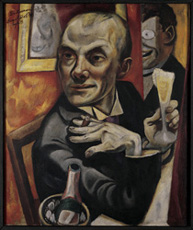 |
| Max Beckmann , Self Portrait with Champagne Glass, 1919. Oil on canvas. Private collection, courtesy W. Wittrock, Berlin. Photo: Kunstsammlung Nordrhein-Westfalen, Düsseldorf© 2006 Artists Rights Society (ARS), New York/VG Bild-Kunst, Bonn |
GLITTER & DOOM: German Portraits from the 1920s
[Closing 19 February 2007]
No, the so-called Weimar Republic [1919-1933] was not governed from that small provincial capital, but from Berlin, in the wake of Germany's devastating defeat by the Allies in The Great War. This was another of those failed efforts at Building Democracies by foreign nations. Adolf Hitler was waiting-in-the-wings: in Landsberg Prison for a while, in fact.
Glitter & Doom, the searing new show at the Met, demonstrates the character-dissections of the artistic-scalpels of a group of savage artist-observers of that tumultuous, economically-disastrous time. Among the talents of the Neue Sachlichkeit on display: Christian Schad, Otto Dix, Max Beckmann, & George Grosz.
These and other German "Verists" not only depicted the actuality of a Corrupted Society as they saw it, but they also added an ironic/satiric dimension of distortion of salient details. Especially in portraits.
If you were a successful doctor, lawyer, jeweler, or even an art-dealer, you might have wanted to think twice before commissioning Otto Dix or George Grosz to paint your picture. Karl Krall was so distraught at his Dix image on canvas that he could not live with it. He gave it to a museum…
Savage as these artists' images were of Weimar Era Life, they were generally kind to themselves when painting self-portraits. In fact, Max Beckmann is fairly generous to a number of his subjects.
But Dix was often downright vicious. There are some 50 of his pictures in this show, so you can imagine what was going on in his mind.
Oddly enough, his portrait of Dr. Fritz Glaser and his family seems fairly straightforward, but his pencil-sketch of this eminent lawyer shows him with uneven eyes and a prominent nose, rather like the subsequent Nazi cartoon-images of Jews. Of course, it's possible that Dr. Glaser really did have such a proboscis…
Far more stylish--in a rather Art Deco mode--the portraits and social-scenes of Christian Schad are also often astonishingly direct. Notably the bizarre duo of Agosta the "Winged One" and Rasha the "Black Dove."
There are 40 paintings and 60 works-on-paper in this exhibition, some of them seldom shown. Well worth a visit, especially if you want to see the Curtain-Raiser for the Rise of the Nazis and the Death of the Weimar Republic.
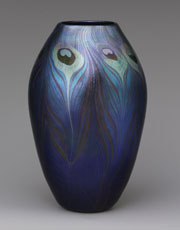 |
| Louis Comfort Tiffany, Tiffany Glass and Decorating Company . Vase, ca. 1900 Favrile glass. The Metropolitan Museum of Art, Gift of Louis Comfort Tiffany Foundation |
LOUIS COMFORT TIFFANY & LAURELTON HALL:
[Closing 20 May 2007]
In these times of feverish Landmark Designations & Historic Preservation, it's difficult to imagine that as recently as 1957, Louis Comfort Tiffany's amazingly beautiful mansion, Laurelton Hall, was already stripped of its Tiffany-designed treasures, abandoned, and left to burn down, an almost total loss.
Fortunately, many of the paintings, decorative-tiles, stained-glass windows, sculptural-details, and fabrics had been purchased by discerning collectors. Thus, it has been possible for Curator Alice Cooney Frelinghuysen and her aides to suggestively recreate a sense of the manor's furnishings and ambiance at the Met Museum.
Dr. Frelinghuysen has also authored a magnificent book--with the exhibition's title--that gives an even more effective visual/textual sense of what Tiffany had achieved, in designing every aspect of the Italianate 84-room-villa and its estate-grounds in Oyster Bay, Long Island.
Beginning this project in 1902, Tiffany was not exactly an originator of the concept that all the exteriors, interiors, decorations, and furnishings of an architect's house should be designed by him alone. In Vienna, Josef Hoffmann was doing the same, as witness the current show at the Neue Galerie!
Frank Lloyd Wright was also a champion of the single-designer concept, but Tiffany's decorations were far more Art Nouveau-ish than either Hoffmann's or Wright's.
Once again, Met Curators have exhumed those delicate 18th century Neapolitan wax, terra-cotta, & bisque Angels, Shepherds, Magi, fun-loving Italian Peasants, and the Holy Family to recreate the Nativity crèches--so dear to the hearts and minds of devout Roman Catholics--to decorate the Met's annual Christmas Tree in the great Medieval Sculpture Hall!
The idea of combining an essentially North German Evangelical-Protestant Tannenbaum [thanks to Martin Luther!] with the Latinate Catholic Nativity-Scene was conceived in 1957, when the late Loretta Hines Howard's collection of Neapolitan figures was shown on--and under--the great tree.
For many Christmases, Mrs. Howard herself arranged the figures and the Nativity, later assisted by her daughter, Linn Howard. Beginning in 1964, Mrs. Howard gave over 200 of these figures to the Met.
Today, Linn Howard continues this tradition, assisted by her daughters Andrea and Stephanie! There are now more than 50 winged-cherubs and delicate angels suspended from the tree-branches! Howard also is adding figures to the collection.
The tree and its 18th century adornments--some by great Italian Masters such as Giuseppe Sammartino and Salvatore di Franco--is/are backed by the immense wrought-iron Choir-Screen from the Cathedral of Valladolid in Spain. Something William Randolph Hearst picked up in his travels…
The Met also as an immense and historic Menorah, so Equal-Time can be observed, but one does not insert a Menorah, no matter how venerable--into a Neapolitan Cradle-scene.
[Is it remotely possible that--just as some super-pious Christians want to "put the Christ back in Christmas"--some Ultra-Orthodox might want to "Put the Hannah back in Hannukah"? Just asking…]
Speaking of Manhattan Christmas-Trees, there was also the Official Lighting of the Great Tree in Rockefeller Center Plaza--which brings all Fifth Avenue traffic to a halt. The 49/50th-streets Rock-Center bus-stops are even removed during the Holiday Season!
This Midtown Lighting now vies with the Lighting of the Lincoln Center for the Performing Arts Christmas Tree. The interesting difference is that LincCenter spectators get a short, smart sampling of ballet, opera, & theatre during the festivities!
In the great rotunda-courtyard of the vast Bloomberg hi-rise, next door to Bloomingdale's and its famed Christmas-windows--there is also an immense Christmas-tree, but decked out in blue-lights!
Then there's the immense electronic Snowflake, suspended over the intersection at 57th & 5th.
Snowflakes--like David-Sternen--have six points, so perhaps Nature ordained at the Creation that Jewish Religious Symbols should automatically have pride-of-place during the Winter Holidays!
Long before Menorahs!
Visitors to Manhattan during the Holidays--as well as Native New Yorkers--should check-out the traditional Animated Christmas-Windows. This may be the last year for Lord & Taylor, threatened with closure.
Macy*s windows are always a delight, with the Miracle on 34th Street suite of animations on view every season.
Saks Fifth Avenue windows regularly draw huge crowds, jostling in line even in the coldest snows. But the best, the most antique-infested & bizarrely-imaginative windows are at Bergdorf's. Across the street, at Tiffany's, the tiny windows are often lovely jewel-box Winter Scenes, studded with diamonds and icicles.
And there are more Messiah concerts than can be counted…
At the Morgan Library & Museum--
[Closing 4 March 2007]
How can you go wrong with a compact exhibition of the fantastic drawings--and the amusing map-projections of New York & the World Beyond--executed by Saul Steinberg?
Answer: You cannot!
Bob Dylan may have seemed an odd-fit for the New & Improved Renzo Piano Morgan Library, but Steinberg is just right: a neat contrast to some of those fantastic Medieval Beasts in the margins of Mr. Morgan's priceless Illuminated Scriptorials & Missals!
There's even a kind of wooden writing-desk/bookcase, but the books are also made of wood. Jack London's White Fang, however, has that name in Slavic on its spine!
Although Steinberg was for many years almost synonymous with The New Yorker and its fabled cartoons, he also used his talents widely before he concentrated on that mag and on creating gallery-art.
One especially amusing Steinberg series was devised for humorist S. J. Perleman's satiric travelogue, Around the World in Eighty Clichés.
You'll want to have the richly-illustrated Steinberg catalogue, even if you cannot come to Manhattan for this show.
At MoMA: The Museum of Modern Art--
MANET & THE EXECUTION OF MAXIMILIAN
[Closing 29 January 2007]
Years ago, your scribe spent some time--contemplating the vagaries of History & Fate--in the tiny cell in the Mexican town of Querétaro, where Maximilian, one-time, and a very short time at that, Emperor of Mexico spent his last night. Before he was executed by a firing-squad on the orders of Benito Juarez, Presidente of Mexico.
I paid for this privilege. I had not been incarcerated by the local Policia.
Then I photographed the wall against which Maximilian and his two generals--Tomás Mejía and Miguel Miramón--were bloodily shot at close-range.
Just how close this range was has largely been determined by the sketches and paintings Edouard Manet made of this historic event--which he did not actually witness.
For the first time in the US, all three of Manet's successive paintings of the Execution, an oil-sketch, and a lithograph have been brought together at MoMA. Viewers can study the evolution of Manet's vision.
They may also fill in some gaps in their knowledge of 19th century history South of the Border. After the brutal murder of the Last of the Aztecs, Moctezuma, by Cortez and his ragtag army, Spain imposed a Viceroy on its Central & South American territories. But no Emperor…
That was the unfortunate idea of Napoleon III of France, who wanted to secure Mexico--newly rebellious under Juarez--for further European Exploitation.
Maximilian was a Habsburg, the Royal & Imperial House that ruled both Spain & Austro-Hungary.
When things went wrong, Napoleon abandoned his puppet-ruler, leaving him to be captured and killed by the Founders of Modern Mexico.
Maximilian's distraught wife, the beautiful Empress Carlotta, went mad.
When I returned to Mexico City from Querétaro, I discovered that friends had Maximilian's marble bath-tub in their gardens!
All these long-ago memories came flooding back at MoMA!
BRICE MARDEN: A Retrospective of Paintings & Drawings
[Closing 15 January 2007]
Years ago in San Francisco, at Station KQED, your scribe interviewed an artist named Brice Marden. He was on some kind of grant--Guggenheim, perhaps?--to discover ways that the wiring and technology of TV sets might be used to create new forms of Video-Art.
Of course, that is now long behind him, and he has developed his own distinctive art-image-vocabulary, which does not depend on TV-wirings.
Nonetheless, the loopy colored rope-like noodle-tangles that distinguish many of his canvases at MoMA may have some submerged inspiration from wire-like or ropish-forms: Huge intertwinings of pastel & darker spaghettis?
Actually, some of these thready-networks are derived from Marden's fascination with grids. The current retro show deals with grids, planes, and "gestures" from the Marden Ouevre.
Asian Calligraphy has been a great influence, and, certainly, ideographs broadly, rapidly painted with thick brushes emphasize the element of gesture in creating an image.
[Closing 5 March 2007]
This on-going exhibition-series--currently featuring some 32 works from MoMA's Klee Collections--is an ingenious way to show off some of the museum's Modernist Treasures that are seldom on view. Here are some Old Klee Favorites and some less familiar images.
SFMoMA also has a excellent & extensive Klee Holdings. Maybe iconically superior to MoMA's?
In any case, whether figuratively-suggestive or more Bauhaus-geometric, Klee paintings & drawings are always an amusing & instructive museum-outing. Do check these out!
Next Up: Focus: David Smith [27 February] and Focus: Alexander Calder [9 March].
OMA IN BEIJING: China Central Television Headquarters
[Closing 26 Febrary 2007]
"Oma" is, of course, a Germanic endearment for a beloved Grossmutter. And, while there is nothing exactly gross about the large-scale and rather fantastic designs OMA has made for the new Peking/Beijing Central TV HQ, it must be duly-noted that OMA stands for the Rotterdam-based Office for Metropolitan Architecture.
Founded by the revolutionary Architectural-Thinker Rem Koolhaas--with partners Elia & Zoe Zenghelis--OMA's ongoing 2004 project for Chinese Television is now metaphorically on-view at MoMA.
Huge photographs, stunningly-devised torqued-building-models, and detailed building-plans offer some amazing insights into what is now possible in a vast nation where once the Thought of Chairman Mao blinkered Chinese eyes and stifled any creative Individual Thought!
Amazing that the Communist Central Committee--or whoever makes these decisions--opted for such a radical OMA design!
As the Chinese have now bought billions of dollars of American war-created national-debt, so they can well afford such projects as this one.
Recent Acquisitions from the Museum's Collections
[Closing November 2007]
Some of the Old-Modernist Furniture-Favorites--such as bentwood-chairs and a cradle--are still on show in MoMA's Architecture & Design Galleries.
But they have recently been re-configured to spot-light new developments in Digital-Design.
Not only can buildings, art-objects, furniture, and other important artifacts of Modern Life be easily devised in three-dimensions on a two-dimensional computer-monitor-screen--unlike the former difficulties of trying to render them in two-dimensional drawing-projections on paper--but some objects can also actually be manufactured with computer-controlled machinery, made possible by innovative software and hardware.
Using conventional methods of furniture-manufacture, there is no way that Patrick Jouin's C2 Solid Chair could have been fabricated. Some of the digital-forms could hardly have been imagined--let alone drawn--with T-square, straight-edges, and translucent plastic triangles, arcs, and circles…
This is a fascinating installation that might give you some ideas of your own about constructing something hitherto thought impossible--if anyone could even have imagined it ten years ago!
Visit MoMA's Philip Johnson Architecture & Design Galleries and discover what CAD software, CAM hardware and CNC computer-numerical-control--cutting through both steel and wood--can do!
At the American Museum of Natural History--
 |
| California Gold Specimen. ©Jackie Beckett/AMNH |
[Closing 19 August 2007]
This glittering show is only slightly less dazzling than AMNH's exploration of Diamonds! Gold does not tarnish; neither do diamonds. But Gold has proved, over Millennia, more valuable as a form of Currency, Collateral, and Institutional Security than any gem-stones.
Unlike previous American Museum shows that have studied precious and semi-precious materials--Pearls & Amber, as well as Diamonds--this amazing installation deals with a Basic Chemical Element, not a carbon-compound or an object created by irritating an oyster or a whale.
As in the previous exhibitions, both natural examples and man-made objects are on display. No less than 700 specimens! 100 of them Natural; 150 of them cultural--jewelry, especially, and 450 historic coins and heavy gold ingots.
As a native of Grass Valley & Nevada City, CA--where, before World War II, some 40 gold-mines were in operation--it was rewarding for your scribe to see some fabulous gold-nuggets from the Mother Lode.
[Even in the Depression 1930s, GV mines such as the Empire, the North Star, and the Idaho-Maryland were producing huge quantities of gold. As an eight-year-old boy-alto in the Cornish Carol Choir, I--having learnt the age-old songs by rote from grizzled old "Cousin-Jack" miners--was singing with the rest on Christmas Eve, my birthday, from the 5,000-foot-level of the Idaho-Maryland Mine. This was broadcast by Twenty-Mule-Team Borax on its Death Valley Days radio-show. Hosted by a young announcer named Ronald Reagan…]
If you want to know more about the Gold Standard, you might want to gaze upon the 27 gold-bars on loan from the Federal Reserve Bank of New York and the US Mint.
These weigh almost 30 pounds each, and they are complemented by 50 smaller ingots, with weights between one and four pounds!
You can also find out how small a speck of gold can be pounded into square-yards of gold-leaf. Amazing!
In the GOLD Gift-shop, you can buy some golden trinkets.
And, in the special Gold Nugget Café, you can sample some California & Klondike Gold-Rush eats. There's Miner's Chicken Stew and Buffalo Chili, with Crisp Cornbread!
The tasty chili is full of chopped-up-buffalo raised "Free-Range" from "Humane Farms." Well, Humane or not, it didn't do these great Bison much good when they reached the Slaughter-House, did it?
Who is the American Museum trying to kid, with "Politically-Correct" or "Environmentally-Friendly" nonsense like that?
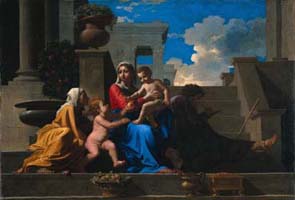 |
| Nicolas Poussin . The Holy Family on the Steps (1648). Oil on canvas. The Cleveland Museum of Art, Leonard C. Hanna Jr. Fund 1981.18 |
DOMENICO TIEPOLO (1727-1804): A New Testament
[Closing 7 January 2007]
Best-known for his series of Italian Commedia characters--especially clowns in tall white tubular hats--Domenico Tiepolo reserved his greatest passion and technical-mastery for religious-subjects.
Little-known until now--with the temporary reunion at the Frick of sixty of the widely scattered individual drawings--is his towering achievement: the New Testament Cycle.
These are remarkable works--not only because of the varied ways in which Tiepolo envisioned & composed the events leading up to Jesus' Birth, His Nativity, His Mission, & His Final Passion--but also because, even as finished drawings, there is a sketchy spontaneity in the lines and a dash in the color-washes.
The cycle may have taken five years to complete, but it was not apparently a commission. Tiepolo kept all the vertically-oriented drawings to himself. After his death in 1804, they were dispersed. Fortunately, a number were preserved in an album, now in the Louvre. Others were widely scattered, and the sixty at the Frick are from this dispersal, now loaned from various museums & collections.
On lamp-posts near the Frick, one of the most Iconic of these drawings hangs as a city-arts-banner. It is also on a handsome carry-bag, available in the museum-shop.
MASTERPIECES OF EUROPEAN PAINTING:
From the Cleveland Museum of Art
[Closing 28 January 2007]
Renovating or expanding an historic museum may be an immediate inconvenience to local art-lovers. But it is almost always a benefit to museums in other cities and countries. Major paintings have to be removed from galleries that need structural or cosmetic repairs.
Rather than consign them to basement-storage, why not lend them out for special exhibitions?
The Cleveland Museum of Art has done just that, with loans of 14 masterpieces to the Frick Collection!
Some are so imposing, only the Frick's Oval Room is spacious enough for their powers. Others are deployed on the walls of the Garden Court. Among the Masters on view are paintings by Fra Filippo Lippi, Andrea del Sarto, Caravaggio, Carracci, El Greco, Frans Hals, Poussin, Zurbarán, Velázquez, David, & JMW Turner!
Notable canvases include David's Cupid & Psyche, Turner's Burning of the Houses of Lords & Commons, Caravaggio's Crucifixion of Saint Andrew, and Del Sarto's Sacrifice of Isaac.
This impressive exhibition is accompanied by a handsome catalogue--with the same show-title--that not only reproduces all the paintings, with invaluable explanatory-texts, but also salutes the Clevelanders who made that noble city's great museum & collections possible. This is also an attractive holiday-gift!
If you purchase a copy, it will surely be given you in a very striking carry-bag, reproducing the Iconic Image of the Frick's Tiepolo exhibition!
CIMABUE & EARLY ITALIAN DEVOTIONAL PAINTINGS
[Closing 31 December 2006]
With the current curatorial passion for reuniting widely-scattered artworks that were once parts of Cycles or Pictorial-Ensembles--notably Altar-Pieces!--the Frick has contributed its own Cimabue-Reunion. Two "diminutive, jewel-like panels" by Cimabue are now on view.
One, the Frick's own Flagellation of Christ, is paired with the National Gallery's The Virgin & Child Enthroned with Two Angels. The latter painting was discovered in a private collection only in 2000, but, thanks the existence of the Frick's panel, it was recognized as a Cimabue, probably from a larger suite of panels.
As Two Panels--no matter how wonderfully envisioned & executed--do not an Exhibition make, there are also some other examples of Renaissance Italian religious-art to enhance this Christmas-tide Reunion.
When visiting the Frick, be sure to look for some recent acquisitions and important temporary loans: Jean-Antoine Houdon's marble-relief of The Dead Thrush, as well as his elegant bust of Madame His. Also worth a search in the galleries: Massimiliano Soldani-Benzi's Pietà with Two Putti Angels, Clodion's Dance of Time wonder-clock, and Paul Cézanne's Pitcher & Fruit.
Special Note:
The Frick's Chief Curator, Colin Bailey, has just written a fascinating book about the Frick, titled Building the Frick Collection. This volume is published by the Frick, in association with Scala Publishers. It can be ordered directly from the Frick: Phone: 212-288-0700, or on the web: www.frick.org! [Hardcover: $24.95/Soft: $14.95.]
To those who have been to the Frick Mansion on Fifth Avenue even once, it will be interesting to discover how this essential Robber-Baron--one-time close-collaborator with Andrew Carnegie: think Coal-mines & Steel-mills!--schooled himself to become one of America's foremost art-collectors, rivaling at times even the insatiable and super-rich J. P. Morgan.
The legendary London art-dealer, Joseph Duveen, must also get some credit. And there's also Knoedler, just down the street from the Frick!
But even more interesting, in this new, richly-illustrated book, is its account of the actual construction of the Frick Beaux-Art Mansion. Vintage black & white photos show stages of its development.
In fact, it replaced the Lenox Library, already an important collection of books, on this very site. The Lenox was then melded into the Astor-Tilden-Lenox Library, better-known as the New York Public Library, on Fifth Avenue, at 42nd Street!
It's a curious fact that Manhattan's two major & historic private art-collections--those of Morgan and Frick--are still housed in the original noble buildings designed to show the paintings, sculptures, books, furniture, and the interior decorations to best advantage.
But, in its urge & need to expand, the Morgan recently & unfortunately decided to Go Renzo Piano Post-Modern, in linking its three major Landmark Buildings. This has provided important & unseen storage & preservation-areas, but it has also created a vast empty glass-world, virtually devoid of charm or art-works. The former handsome historic ensemble--once linked by a Beaux-Art Corridor and a small modern Atrium--has been effectively obliterated, replaced by some box-like confined & confining exhibition-spaces.
The Frick has been much more careful about expansion. To construct the adjoining Frick Art Reference Library, facing East 71st Street--and your scribe's co-op!--it was necessary to destroy some noble town-houses, but the actual library-building does not clash with the Gilded-Age style of the Frick Mansion.
Three more handsome town-houses were destroyed on East 70th Street, when the Frick wanted to expand its Entrance-Amenities for the hordes of museum-visitors which regularly storm the premises. I watched these virtual mini-Chateaux being demolished: it was perhaps an unnecessary loss.
Most of the street-frontage that replaced these Lost Landmarks was replaced by a heavy black wrought-iron-fence, forbiddingly enclosing a beautiful formal garden. Into which the public cannot go…
Even as a Member of the Arts-Press, I've never been in this street-visible, but nonetheless Secret Garden. Nor have I ever seen anyone standing or moving about in it. Perhaps this happens when the Frick has a Gala for its Board & Patrons?
For that matter, I've never been upstairs on the second-floor of the Frick Mansion, where the Family had its quarters, when not in Pittsburgh, at Clayton, the Frick Victorian-Gingerbread Manse.
But I have been down in the basement, where the Frick Bowling-Alley is still in place!
At the Clayton Estate, there is a children's bowling-alley in the Frick Playhouse! The entire estate--with several museums--is worth a holiday-visit, as Clayton itself is annually decked-out for a Victorian Christmas!
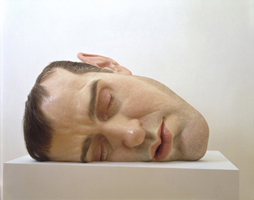 |
| Ron Mueck. Mask II, 2001-2002. Private Collection, Atherton, California |
[Closing 4 February 2007]
The ingenious Aussie-born sculptor Ron Mueck is no stranger to the Brooklyn Museum--formerly known as the Brooklyn Museum of Art. One of his larger-than-life--but all-too-lifelike--male-heads was shown in the framework of a Charles Saatchi show there.
Most of the twelve Mueck humanoid-constructions now on view on Eastern Parkway were shown this past summer in Edinburgh at the Royal Academy Gallery, where they attracted curious crowds.
Including your scribe, who was wowed by the immense sculpture of a woman in bed, lying on a thin pad on the museum-floor, her knees drawn up, her head propped on a pillow. This work is called In Bed! And it's also on view in Brooklyn.
If my memory fail me not, Mueck's Two Women was shown before at the Brooklyn Museum. These are small, almost doll-like figures of two old grannies in long winter-coats. The faces are so detailed, so lifelike that they could be real gossips, reduced to elf-size in some kind of Infernal Shrinking-Machine.
Mueck is also fond of Masks. Nor does he modestly shy-away from full-frontal-disclosure. His Wild Man is even pushing his pelvis forward on his wooden-stool.
These have to be seen to be Believed, as the saying goes…
Mueck's technical skills are amazing.
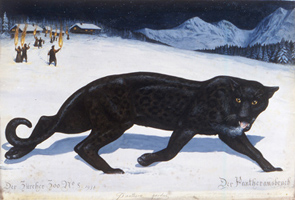 |
| Walton Ford. Der Panterausbruch, 2001. Courtesy of Paul Kasmin Gallery |
[Closing 28 January 2007]
Walton Ford's remarkable watercolors of animals, birds, snakes, & flora combine immense technical-skill with an eye for exacting natural detail. They also often incorporate bizarre visual elements: a Python, or is it a Boa, with a tiny bird-cage on its head. Or a Peacock--with its beautiful tail on fire!
These are even more impressive, given their large scale and vivid colors. There are over 50 of these images on display. Ford explores, in his distinctive Nature-Metaphor, such issues as Colonialism, the Extinction of Species, and the Naturalist Tradition.
The famed British explorer, Sir Richard Burton, is amusingly mocked in Dirty Dick's Aide de Camp, in which a monkey serves as Burton's servant.
Illustrators such as Edward Lear, Sir John "Alice in Wonderland" Tenniel, and JJ Grandville have been obvious inspirations. As also the painters Francisco de Goya y Lucientes and George Catlin. And, of course, John James Audubon--who is buried in Trinity Church Cemetery, way up on Manhattan's 150th & Broadway: Audubon Terrace, if you will…
Audubon's famed series of Birds of America were not painted from the Life. Audubon shot the noble birds, stuffed them, or preserved their skins & feathers, from which he then painted them in great detail.
Ford deals with this satirically in Delirium, in which a trapped Golden Eagle flies away, still dangling the trap, as a miniature Audubon lies prostrate in the snow below!
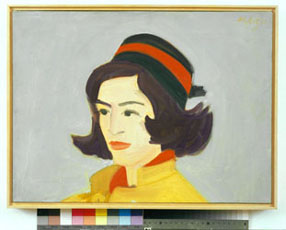 |
| Alex Katz, Ada in Pillbox Hat, 1961. Collection Paul J. Schupf, Hamilton, New York. Art © Alex Katz/Licensed by VAGA, New York, NY. |
[Closing 18 March 2007]
Alex Katz was one of those few New York artists whose interesting billboard-style designs were recently painted on the brick-walls of buildings variously in the Bowery, Hudson, and on Canal. I watched his work being translated from a small design to a much larger format above the Bowery Bar, at the intersection of East 4th Street & the Bowery.
I don't imagine he was one of the professional sign-painters at work.
But his large canvases, devoted entirely to images of his wife, Ada--also obviously his Muse, have a curiously flat billboard-art quality to them. Don't look for skin-pores or hair-follicles.
For me, the most arresting of these Ada-Images at the Jewish Museum was a thin vertical partial-Ada--not the whole face--vivid in red.
[Speaking of KatzRed, there are several Ada-like faces--set into a red-ground--in the KRIZIA holiday-windows on Madison Avenue. Can these be Katzes? I'm afraid to go in and ask, as most of these horrendously-pricey women's fashion-boutiques on this part of Madison are inhabited, not by customers, but by black-clad sales-people, waiting to pounce on Potential Consumers.]
The museum's PR-release is headed thusly: EXHIBITION FEATURES PAINTINGS CREATED OVER 48 YEARS BY ONE OF THE MOST IMPORTANT POSTWAR AMERICAN PAINTERS. [Italics added: ed.]
This is Alex Katz you're talking about?
If this is a loving, painterly Obsession, it offers diminishing returns. How about trying out a series on Hilary Clinton?
JOSEF HOFFMANN: Interiors, 1902-1913
[Closing 26 February 2007]
For admirers & collectors of Art Deco and Moderne, the creations of such brilliant turn-of-the-century/Jahrhundertwende Viennese talents as Josef Hoffmann and Kolo Moser--often working with the famed Wiener Werkstätte--seem even today as Modern as they were way back in 1902 and beyond.
Now, with "the first exhibition of its kind" at the Neue Galerie, four of Josef Hoffmann's elegantly simple interiors have been recreated. None of the handsome paneling of the Fifth Avenue chateau's great chambers has been damaged: the rooms stand free of the walls.
Like Scotsman Charles Rennie Macintosh--whose architectural & decorative innovations were much admired in Vienna, if not at home--Hoffmann insisted on ensemble design & décor. Frank Lloyd Wright was soon to follow his lead.
As so handsomely demonstrated at Fifth & 86th, Hoffmann not only designed the furniture & wall-coverings, but also all the fabrics, ceramics, cutlery, and objects-d'art. What is especially striking about all four interiors--two of them bedrooms--is the eminent practicality/functionality of the layouts and the actual furnishings!
But--functional though they may be--they are still impressively Modern & Handsome.
There is also the dining-room from the Stonborough-Wittgenstein residence in Berlin, as well as the Geneva dining-room of the Swiss painter, Ferdinand Hodler!
In Brussels, the Palais Stoclet--a remarkable example of this Vienna ensemble-design of building, interiors, and furnishings--is said to be in almost its original condition, as it remains in the family.
Incidental Note: Some years ago, I created a special Vienna issue of The Modernist, focusing on the architecture & designs of Hoffmann, Otto Wagner, & Kolo Moser, as well as the arts & crafts of the Wiener Werkstätte.
For this issue, the famed Austrian textile-firm of Backhausen, in the Kärtnerstrasse, gave me samples of original fabric-designs for illustrations.
DIE GOLDENE ADELE & GUSTAV KLIMT:
The Saga Continues: Art-Prices Soar!
Taking my cue from a German newspaper this past summer--as I was on the Opera-Festival Road--I reported that Gustav Klimt's jewel-like portrait of Adele Bloch-Bauer I had sold for $145,000,000 to the Neue Galerie's founder, Ronald Lauder.
Actually, the figure was only $135,000,000 not $145,000,000! What's a mere ten-million when you are buying a work that is so breathtakingly beautiful--and now Art-Historic as well!--that it should be Beyond Price?
When Die goldene Adele went on view at the Galerie, it was joined by Adele Bloch-Bauer II and three other Klimt canvases that had belonged to the late Adele and her husband, before they were confiscated by the Nazis. After World War II, they were exhibited in Vienna's Belvedere Palace Gallery.
After protracted court-battles, however, all five paintings were awarded to Maria Altmann, heir to the Bloch-Bauer artworks. Early in November, the other four went for auction at Christie's. Adele No. 2 was sold for $87,900,000. At that time, the name of the private buyer was unknown, as bidding was done by a Christie's official.
The New York Times reported the $87 million-plus as a sales-record for Klimt. Surely $135,000,000 outweighs this? Or did Carol Vogel only mean auction-sales?
At the Whitney Museum of American Art--
From the Bauhaus To the New World
[Closing 21 January 2007]
Even great men may be forgotten, if they have not left behind a devoted--even obsessed--widow, mother, or sister to perpetuate their Legend, Lifework, and any surviving Manuscripts, Artworks, or Artifacts. In this regard, Lázló Moholy-Nagy was fortunate. Your scribe first became aware of his Bauhaus-Modernist designs at UC/Berkeley, where Sybil Moholy-Nagy carried his Torch.
Now, some of his most colorful geometrics & schematics are on view at the Whitney. As are some powerful abstract-designs of Josef Albers. There are some 170 works on display, spanning four decades.
As the Whitney is devoted to American Art & Artists, one might ask what these refugees from the Bauhaus are doing at the Whitney, when they should be more at-home over at MoMA?
Actually, after they fled the Nazis when the Bauhaus was closed in 1933 and came to America, they made themselves effectual American artists with European Roots. Albers taught at Black Mountain and later, at Yale. Moholy-Nagy founded the New Bauhaus in Chicago.
KIKI SMITH: A Gathering, 1980-2005
[Closing 11 February 2007]
Not to be confused with Dances at a Gathering, or similar social-gatherings, Kiki Smith's first American museum-retrospective is, instead, a gathering of her disparate and often-challenging works over a quarter-century-career.
With a through-thread of Feminist Concerns, there are, nonetheless, a variety of inspirations in her sculptures and constructions. There is also wide variety of media & materials used to achieve her unique visions: glass, beeswax, papier-mâché, & bronze, not to overlook her prints, drawings, photos, films, & installations!
How about her female-forms in Lilith, Virgin Mary, Daughter, Eve, Blue Girl, and Untitled?
Unfortunately, Untitled--as with many other modern artists--is also the title of another quite different artwork: a lithograph that looks like a mass of matted hair: possibly female? This was a gift of Agnes Gund to the Walker Art Center in Minneapolis!
How can Curators catalogue the hundreds--perhaps thousands--of modern artworks which bear the same Untitled title? If they are Abstract--as is often the case--Subject-Matter is no aid in classification or archival-retrieval.
SPANISH PAINTING FROM EL GRECO TO PICASSO:
[Closing 28 March 2007]
This season, Picasso is the hands-down Winner & Star at several major museums. Not only at the Guggenheim, but also at the Met and the Whitney--even though Gertrude Vanderbilt Whitney founded it with a view to promoting American Artists! And, of course, he always has Pride of Place at MoMA…
And, although the Guggenheim itself was created to promote Modern Art--not least Sol Guggenheim's collection of Kandinskys--it has recently seen fit to fill its rotunda with chronological arts-surveys from such Far Countries as China, and Mexico, closer to home.
The current show is a Chronology of Great Spanish Painters--exemplified by some of their more interesting canvases. Initially, the Big News was that one of the paintings had been stolen in transit.
Art-Movers are, of course, insured, but you don't want to lost a Masterpiece between America's Heartland and Gotham… As the missing painting was shown on TV--and a big reward posted--someone recognized the picture in the home of the thief. Now, it's back on the walls of the Guggenheim.
The Iconic Image for this show is displayed in a special triangular gallery, off the main Frank Lloyd Wright Rotunda. And it's also reproduced--in very large format--on the scaffolding on the façade of the Renovation-in-Process museum. It is Zurbarán's White-friars Dinner-scene: Saint Hugh in the Refectory.
The [approximately] 140 paintings provide a survey from the 16th century into the 20th. Of course you will see powerful works by Velázquez, Murillo, Ribera, Espinosa, Coello, El Greco, Gris, Goya, Miró, Dalí, & Luis Meléndez.
Meléndez?
And why not? Spanish Painting is more than Big Names…
At the New York Public Library for the Performing Arts--
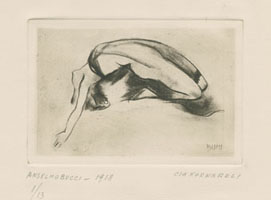 |
| Cia Fornaroli. Drypoint by Anselmo Bucci, signed and dated 1918. Cia Fornaroli Collection, Jerome Robbins Dance Division, The New York Public Library for the Performing Arts. |
Treasures from the Cia Fornaroli Collection
[Closing 20 January 2007]
Not only is this exhibition an intriguing survey of the development of Ballet from early Renaissance Court-dances and the popular Italian Commedia, but it also suggests the development of Opera from such entertainments.
The fascinating visuals and manuscripts on view at Lincoln Center are only the tip of the metaphoric archival-iceberg of the collection Walter Toscanini and his wife, the ballerina Cia Fornaroli, donated to the Library for the Performing Arts.
Some of the earliest forms of Dance-Notation are on view: Chorégraphies [no O] showed the steps of the dances as foot-prints placed along the twisting, twirling line of the staff of the actual music for the dances! The laid-out staff indicated the progress of the dancers on the floor!
Although the focus is on Italian Dance, this compact show demonstrates how quickly Italian dance-masters and famed dancers spread their art across Europe, especially to St. Petersburg and Paris!
There are portraits of the Greats--Taglioni & Grisi--as well as early film-footage of astonishing program-ballets. The monumental teaching-influences of Carlo Blasis and Enrico Ceccheti are also saluted & documented. [Ceccheti ballet-training was central to the Jazz-dance created by Broadway's Jack Cole!]
As is now a regular feature of NYPL exhibitions, there is also a handsome & richly-illustrated Italian Dance souvenir-brochure that unfolds like a Japanese-screen. Indeed, that is exactly the effect of the brochure for the Japanese Book show at the Main Libe on 42nd Street!
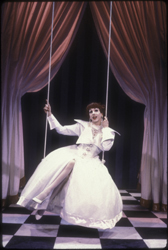 |
| John Epperson as Lypsinka in Lypsinka! A Day in the Life, Perry Street Theatre, 1992. Photograph by Martha Swope. The Billy Rose Theatre Division, The New York Public Library for the Performing Arts. |
STARS & TREASURES: 75 Years of Collecting Theatre
[Closing 5 May 2007]
The High-Point of the press-preview for this wide-ranging salute to the Performing Arts Library's rich theatre-collections was the appearance of Joel Grey!
Not only did he handsomely salute the Library and its Collecting, Research, & Exhibition activities, but he also demonstrated his very own trick Touring-Trunk, a major object in this entertaining show. It has interesting Internal Features audiences would hardly suspect when Grey used it onstage. Outside, it is emblazoned with stickers from great Grey shows such as Cabaret and George M.
Of course there is a Gypsy-Robe, passed on by show-dancer-gypsies from the newest Broadway Musical to the next one, a distinctive symbol added for each show.
Portraits of Stars of the Past vie for attention with wonderful posters for such spectacular shows as Max Reinhardt's The Miracle--for which Norman Bel Geddes transformed the Century Theatre into a Cathedral!
There are also programs, posters, & production-photos for such performers as Harry Houdini, Sarah Bernhardt, Ellen Terry, Edwin Booth, Mrs. Leslie Carter, Laurette Taylor, & Ethel Merman.
Amazing as all these items are, they are only a small sampling of the Library's actual collections. Some of the objects, however, have been loaned for the show by Broadway Stars.
NYPL Book-Note:
At the NYPL midtown Main Reference Library, on 42nd Street, the two elegant marble Library Lions still stand guard. Some Christmases, they even have had big green wreaths around their necks.
But these historic jungle-cats have also sported Crowns, Tricornes, Hard-hats, Top-hats, & Pink-Glasses!
Pictures of the Lions thus decorated are among the visual treats in the charming history of these Literary Lions, newly published as Top Cats, by Susan G. Larkin.
If you buy it as a gift, take a moment before you wrap it to find out who the sculptor was. As well as other odd bits of information. Traditionally, the cats are known as Patience & Fortitude!
You can purchase a copy for $19.95 at the NYPL gift-shop. Or go online!
At the Bard Graduate Center Galleries--
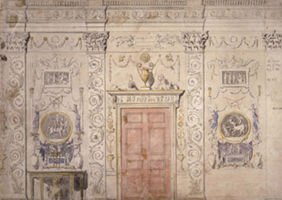 |
| James Stuart, giltwood settee from Spencer House. Victoria and Albert Museum |
JAMES "ATHENIAN" STUART, 1713-1788:
[Closing 11 February 2007]
The handsomely-illustrated Gallery Guide for this Bard Grad Center installation is a Virtual Exhibition on its own!
If you are unable to see the actual show--with James Stuart's original on-site measurements & drawings of Greek & Roman Antiquities--this spiral-bound handbook will make a valuable addition to your library.
Although the Ruins of Athens and the crumbling, plundered remains of Il Foro Romano had been bleaching in the Mediterranean sun for centuries, Stuart was the first artist-draftsman to make a detailed exploration & definitive recording of these impressive--if often shattered--Monuments of the Ancient World.
With the private-subscription-publication of Stuart's The Antiquities of Athens, the Neo-Classic Revival was launched in England, soon to follow on the Continent. Copies of this work are of course on view.
But it wasn't only Stuart's drawings of the ruins and his conjectural-reconstructions that influenced architects, artists, & designers. Stuart himself began to design structures, interiors, furnishings, and objects.
Among the classical-applications shown at the Bard Gallery are Stuart's interiors for Spencer House and Kedleston Hall.
[The latter had especial interest for your scribe, as Kedleston was the "ancestral" home of Lord Curzon, Viceroy of India and Lord of the Cinque-portes. His daughter, Baroness Ravensdale of Kedleston--an hereditary peer, but also a Life-Peer--had befriended me when I was teaching in Britain.
[I met Ravensdale first on Christmas Eve--my birthday--when she received me in her bed-chamber, recumbent with a cold, surrounded by jeweled-crosses and silver-framed photos of her illustrious father, whose hopes of becoming Prime Minister were dashed by Stanley Baldwin.
[She was amazed--and delighted--that any American should know anything about her father. And even more so that I knew it was he who "drew" the Curzon Line in Poland.
[The Baroness--who had known Charlie Chaplin & Mary Pickford when she spent some time in Hollywood--was almost weeping that the handsome ceramic plate, just sent her by the Archbishop of Canterbury as a Christmas gift, had been broken in transit. I was able to mend it with Duco-cement, to her immense pleasure. Later, she took me to lunch in the Lords…
[I found a copy of her personal-memoir, In Many Rhythms, hidden behind some religious-books at Burnes & Oates. It had been judicially-suppressed, after an action by Oswald Moseley, leader of Britain's home-grown Fascists. In it, she had discussed him and his marriage to Diana Mitford. Ravensdale had seen to the education of their children when they were in prison during World War II.
[I was going to ask her to autograph it, but a mutual-friend advised me not to show it to her, as she no longer had a copy herself. And she would surely take it from me--as a gift, even if not freely-given.]
At the New-York Historical Society--
NEW YORK DIVIDED: Slavery & the Civil War
[Closing 3 September 2007]
Many modern New Yorkers do not realize that many New Yorkers during the Civil War were not eager supporters of Mr. Lincoln's Agenda. Bankers & traders, manufacturers & distributors: all had something to lose were the Confederates to be defeated.
Nor were the White Working-classes enthusiastic about potential job-competition from newly-freed Southern Slaves. Even the Free Blacks in Manhattan posed a possible threat. "No Irish Need Apply" signs were still in many windows, as well as such notices as "Restricted Rentals." This was an obvious warning to recent Italian, German, & Jewish Immigrants.
The current exhibition at the New-York Historical Society explores many of the issues of these troubled times, with emphasis on the Black Experience.
In addition to important documents, visuals, and artifacts--there is the actual lottery-box for the Draft-Drawings for the Union Army!--there are a number of inter-active multi-media stations dealing with the issues, which should be especially attractive for school-groups.
One important aspect of the show is the spot-lighting of largely forgotten New Yorker-leaders of various ethnic groups. Nor do many New Yorkers today--even African-Americans--realize the impressive contributions made to the Negro Community in Manhattan by some outstanding Black men & women.
Approaches to Spirituality in Art
[Closing 3 Febrary 2007]
You may not immediately think of Fairytales when you look at a Kandinsky canvas, but Walt Disney drawings and film-cells certainly qualify. At the Galerie St. Etienne, these artworks, and more, are currently on view.
Among the artists represented in this compact show: Kiki Smith--currently also at the Whitney, Leonard Baskin, Henry Darger, Paul Klee--currently spot-lighted at MoMA, Alfred Kubin, Oskar Kokoschka, Pablo Picasso--currently all over town, Max Pechstein, Emil Nolde--currently & always at the Neue Galerie, and, of course, Sister Gertrude Morgan!
Check Them Out! And also get a copy of Jane Kallir's catalogue-essay on the concept of this show. These brief, but intriguing, commentaries should be collected into book-form!
This fall at the Armory on Park Avenue, a number of attractive Antique & Art sales-shows were variously mounted. My favorites are always Sanford Smith's Modernism and his Works on Paper.
But the ART 20 International Art Fair was also bursting with interesting artworks & objects.
Your scribe had made copious notes--and even photographed some outstanding graphics & collectibles--but he now sees that we are on Page 20 of this report. And it is almost Christmas Eve, so it is time to put a period to 2006!
But mark your 2007 Calendar for the OUTSIDER ART FAIR, at the Puck Bldg, from 26-28 January! You will surely find there all the Henry Darger you can take.
Copyright © Glenn Loney 2006. No re-publication or broadcast use without proper credit of authorship. Suggested credit line: "Glenn Loney, Curator's Choice." Reproduction rights please contact: jslaff@nymuseums.com.
Return to Curator's Choice Table of Contents